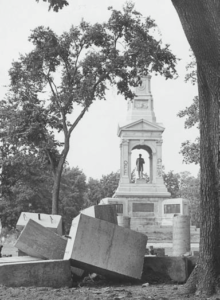
Rediscovering the Howard Industrial School: Freedom, Work, and Black Womanhood in Nineteenth-Century Cambridge
Above Image: An artist’s impression of a Freedmen’s Bureau Industrial School in 1866. (Image via House Divided: The Civil War Research Engine at Dickinson College)
By Beth Folsom, 2023
By the time of the Civil War, enslavement had been illegal under Massachusetts law for almost eight decades. But the end of formal enslavement for Black peoples in the state did not mean that they were free from racial discrimination, or that Black residents enjoyed the same rights and protections afforded to their white neighbors. Even in a city like Cambridge, with its relatively large number of antislavery organizations, racism was alive and well in the mid-nineteenth century. People of color — both those born in the North and those migrating here from other parts of the country — felt the effects of racial bias in their everyday lives. This race-based prejudice was compounded by gender bias for Black women. The freedwomen who ventured North in search of economic opportunity during and after the Civil War found themselves at a particular disadvantage.
In August of 1868, The Cambridge Chronicle featured an article on the Howard Industrial School, located in Cambridgeport. The editor explained that the school’s “object is to receive such colored women and children as come from the South friendless and homeless, to fit them for usefulness as servants, and to find places for them where they will be justly and kindly treated.” By this time, the school had been in operation for three years. It was one of a number of such schools established around the country during and just after the Civil War to house, educate, and employ formerly-enslaved men, women and children.
Although the Howard School was only open for five years, from 1866-1871, hundreds of Black women and children passed through its doors. As an important fixture in the Cambridgeport community in the Reconstruction era, the school conveyed crucial messages about the role of both Black and white women in nineteenth-century America. It also showed the ways in which Cambridge and its surrounding communities viewed the place of freedpeople in post-war society.
As the Union Army moved through the South during the Civil War, their presence spurred many enslaved people to flee to the Army camps and the promise of freedom. Some had already escaped enslavement on their own. Others came to Union lines as a result of the Army’s arrival and the promises of President Lincoln’s Emancipation Proclamation, which declared that, as of January 1, 1863, “all persons held as slaves within any State or designated part of a State, the people whereof shall then be in rebellion against the United States, shall be then, thenceforward, and forever free.”
Despite the fact that Lincoln proved to be motivated more by the potential economic and military effects of declaring enslaved workers in Confederate states “free” than by philanthropic sentiment, the Proclamation resulted in a mass exodus of Black Southerners from their places of bondage. The question for the federal government then became what to do with all of the freedpeople who were congregating in cities such as Washington, DC, Richmond, and Charleston.
The Freedman’s Bureau was established in the wake of the war. It had the goal of helping the formerly enslaved transition to life after enslavement. The Bureau provided food, clothing, shelter, education, and vocational training. Nonetheless, it was run largely by white elites and the vision of what constituted the “proper” resources for the freedpeople was highly circumscribed.
In 1866, Charles Howard, a former Union Army General from Maine who was a commissioner with the Freedman’s Bureau, requested that the antislavery community in the Cambridge/ Boston area take on the task of establishing a school that would help to siphon off some of the burgeoning population of freedpeople in Washington, DC, while providing “opportunities for them to acquire habits of industry and self-dependence.” A committee of Cambridge-area residents, headed by the antislavery activist Anna Lowell, made the arrangements for an industrial school to open in a building on Putnam Street owned by prominent Cambridgeport landowner Elijah Goodrich.
By November of 1866, the Howard Industrial School was open, housing 23 women and children sent north from Washington. Two years later, in its 1868 report, the school stated that over 460 freedwomen and children had already passed through its doors. Women and older girls were trained as domestic servants. Meanwhile, the younger children attended a primary school under the tutelage of white women teachers.
Following their training, women would be placed with wealthy white families in Boston and Cambridge. Even before the school opened, more than 200 requests for servants had been received from local households. According to Anna Lowell, the school’s goal was “to take girls and women and teach them and then get them good places….Instead of living in poverty and dependence they are all supporting themselves by honest labor, and their children will be more benefited than they.”
The idea that Black women and girls were best suited to domestic service underpinned Lowell’s assertion. Furthermore, it assumed that they required special training to be able to perform these duties in New England households. Many of the freedwomen who attended the Howard School had been enslaved in Southern homes. Thus they knew well how to cook, clean, and take care of white children. But the role of schools like Lowell’s was not to educate so much as it was to regulate both the moral and economic world of Black womanhood in post-war America. Lowell and many of her Cambridge-area contemporaries had long been opposed to the institution of enslavement. Nevertheless, that did not mean that they embraced racial equality and true integration. As many freedpeople were moving north during Reconstruction, whites grew increasingly concerned about the impact that this influx of migrants would have on their communities.
Institutions like the Howard School also reinforced stereotypes about both Black and white womanhood through their insistence on a single-sex environment. Lowell and other white women reformers cited the potential for sexual exploitation of Black women―a frequent occurrence under slavery―as a reason for women-only training schools. Yet the reality of domestic employment, even in New England, was that the women living and working in private households were just as isolated and unempowered to reject the sexual advances of their Northern employers as they had been while enslaved. Instead, the industrial schools themselves became a means by which elite white women could exercise control over Black women and children. They thereby garnered the attention and respect of a political system dominated by white men.
By creating a space run by white women, Lowell and her contemporaries in the Freedman’s Bureau were able to carve out a place for themselves in a society that placed white womanhood on a pedestal. Meanwhile, it denied them true political or economic equality with white men. In nineteenth-century America, white women were considered to be the natural caregivers, nurturers, and educators for children―both white and Black. By extension, this applied to the “dependent” and “childlike” women transitioning out of enslavement. Although those running the industrial schools purported to be empowering Black women through paid work as domestic servants, the paltry wages paid by even the wealthiest Northern families ensured that Black women would never achieve economic parity with white women.
In a society that upheld the ideal of womanhood as inextricably linked to domesticity, the fact that Black women needed to work outside the home to support their families meant that they would never achieve “true” womanhood. At the same time, their effective marginalization into low-paying jobs as servants also ensured that they would not be able to support their families through their labor alone. Therefore they continued to be dependent on the economic support of Black men.
Although the women attending these schools had relatively few opportunities to push back against their harsh conditions, one way to do so was to cut their time at the school short in favor of an earlier start date with their new employers. With so many elite white families in and around Cambridge clamoring for Black servants, many of the freedwomen were able to enter live-in service with only a short stay at the Howard School.
The author of the August 1868 Cambridge Chronicle article praises the Howard School for its successes, but his choice of words illuminates the view that post-war white society had of the role that such institutions should play in helping freedpeople adjust to life after enslavement. Calling the school “an indispensable charity,” the author refers to its students as “inmates,” further entrenching the notion that Black Americans were in need of continued discipline and surveillance despite―or, perhaps, because of―the abolishment of the enslavement system.
The Howard School, like the other industrial schools created by the Freedman’s Bureau, functioned just as much to control the economic and moral destiny of freedpeople as to educate and uplift them. Although these institutions were short lived, particularly in the North, they played an important role not only in the transition of formerly-enslaved people to the realities of post-war life, but also in the changing constellation of Cambridge’s racial and migrant population as the country struggled to come to terms with its reconstruction.
Beth Folsom is programs manager for History Cambridge.
This article was originally published in our “Did You Know?” column in Cambridge Day.






